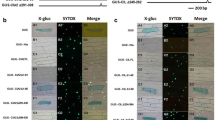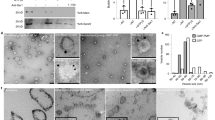Abstract
Dynamin-related proteins are high molecular weight GTPase proteins found in a variety of eukaryotic cells from yeast to human. They are involved in diverse biological processes that include endocytosis in animal cells and vacuolar protein sorting in yeast. We isolated a new gene, ADL2, that encodes a dynamin-like protein in Arabidopsis. The ADL2 cDNA is 2.68 kb in size and has an open reading frame for 809 amino acid residues with a calculated molecular mass of 90 kDa. Sequence analysis of ADL2 revealed a high degree of amino acid sequence similarity to other members of the dynamin superfamily. Among those members ADL2 was most closely related to Dnm1p of yeast and thus appears to be a member of the Vps1p subfamily. Expression studies showed that the ADL2 gene is widely expressed in various tissues with highest expression in flower tissues. In vivo targeting experiments showed that ADL2:smGFP fusion protein is localized to chloroplasts in soybean photoautroph cells. In addition experiments with deletion constructs revealed that the N-terminal 35 amino acid residues were sufficient to direct the smGFP into chloroplasts in tobacco protoplasts when expressed as a fusion protein.
Similar content being viewed by others
References
Aebi M, Fah J, Hurt N, Samuel CE, Thomis D, Bazzigher L, Pavlovic J, Haller O, Staeheli P: cDNA structures and regulation of two interferon-induced human Mx proteins. Mol Cell Biol 9: 5062–5072 (1989).
Altschul SF, Gish W, Miller W, Myers EW, Lipman DJ: Basic local alignment search tool. J Mol Biol 215: 403–410 (1990).
Ausubel FM, Brent R, Kingston RE, Moore DD, Seidman JG, Smith JA, Struhl K: Current Protocols in Molecular Biology. Greene Publishing Associates/Wiley-Interscience, New York (1989).
Bruce WB, Christensen AH, Klein T, Fromm M, Quail PH: Photoregulation of a phytochrome gene promoter from oat transferred into rice by particle bombardment. Proc Natl Acad Sci USA 86: 9692–9696 (1989).
Buvinger WE, Michel H, Bennett J: A truncated analog of a pre-light-harvesting chlorophyll a/b protein II transit peptide inhibits protein import into chloroplasts. J Biol Chem 264: 1195–1202 (1989).
Carde JP, Joyard J, Douce R: Electron microscope studies of envelop membranes from spinach plastids. Biol Cell 44: 315–324 (1982).
Chen MS, Obar RA, Schroeder CC, Austin TW, Poodry CA, Wadsworth SC, Vallee RB: Multiple forms of dynamin are encoded by shibire, a Drosophila gene involved in endocytosis. Nature 351: 583–586 (1991).
Church GM, Gilbert W: Genomic sequencing. Proc Natl Acad Sci USA 81: 1991–1995 (1984).
Cook TA, Urrutia R, McNiven MA: Identification of dynamin 2, an isoform ubiquitously expressed in rat tissues. Proc Natl Acad Sci USA 91: 644–648 (1994).
Damke H, Baba T, Warnock DE, Schmid SL: Induction of mutant dynamin specifically blocks endocytic coated vesicle formation. J Cell Biol 127: 915–934 (1994).
David SJ, Vierstra RD: Soluble derivatives of green fluorescent protein (GFP) for use in Arabidopsis thaliana. Weeds World 3: 43–48 (1996).
Dombrowski JE, Raikhel NV: Isolation of a cDNA encoding a novel GTP-binding protein of Arabidopsis thaliana. Plant Mol Biol 28: 1121–1126 (1995).
Douce R, Joyard J: The regulatory role of plastid envelope during development. In: Baker NR, Barber J (eds) Chloroplast Biogenesis, pp. 71–132. Elsevier Science Publishers, Amsterdam (1984).
Feinberg AP, Vogelstein B: A technique for radiolabeling DNA restriction endonuclease fragments to high specific activity. Anal Biochem 132: 6–13 (1983).
Ferguson KM, Lemmon MA, Schlessinger J, Sigler PB: Crystal structure at 2.2 Å resolution of the pleckstrin homology domain from human dynamin. Cell 79: 199–209 (1994).
Gammie AE, Kurihara LJ, Vallee RB, Rose MD: DNM1, a dynamin-related gene, participates in endosomal trafficking in yeast. J Cell Biol 130: 553–566 (1995).
Gout I, Dhand R, Hiles ID, Fry MJ, Panayotou G, Das P, Truong O, Totty NF, Husan J, Booker GW, Campbell ID, Waterfield MD: The GTPase dynamin binds to and is activated by a subset of SH3 domains. Cell 75: 25–36 (1993).
Gu X, Verma DPS: Phragmoplastin, a dynamin-like protein associated with cell plate formation in plants. EMBO J 15: 695–704 (1996).
Gu X, Verma DP: Dynamics of phragmoplastin in living cells during cell plate formation and uncoupling of cell elongation from the plane of cell division. Plant Cell 9: 157–169 (1997).
Guan K, Farh L, Marshall TK, Deschenes RJ: Normal mitochondrial structure and genome maintenance in yeast requires the dynamin-like product of the MGM1 gene. Curr Genet 24: 141–148 (1993).
Herskovits JS, Burgess CC, Obar RA, Vallee RB: Effects of mutant rat dynamin on endocytosis. J Cell Biol 122: 565–578 (1993).
Herskovits JS, Shpetner HS, Burgess CC, Vallee RB: Microtubules and Src homology 3 domains stimulate the dynamin GTPase via its C-terminal domain. Proc Natl Acad Sci USA 90: 11468–11472 (1993).
Hinshaw JE, Schmid SL: Dynamin self-assembles into rings suggesting a mechanism for coated vesicle budding. Nature 374: 190–192 (1995).
Horisberger MA, McMaster GK, Zeller H, Wathelet MG, Dellis J, Content J: Cloning and sequence analysis of cDNAs for interferon-and virus-induced human Mx proteins reveal that they contain putative guanine nucleotide-binding sites: functional study of the corresponding gene promoter. J Virol 64: 1171–1181 (1990).
Hugueney P, Bouvier F, Badillo A, D'Harlingue A, Kuntz M, Camara B: Identification of a plastid protein involved in vesicle fusion and/or membrane protein translocation. Proc Natl Acad Sci USA 92: 5630–5634 (1995).
Jones BA, Fangman WL: Mitochondrial DNA maintenance in yeast requires a protein containing a region related to the GTP-binding domain of dynamin. Genes Devel 6: 380–389 (1992).
Karlin-Neumann GA, Tobin EM: Transit peptides of nuclear-encoded chloroplast proteins share a common amino acid framework. EMBO J 5: 9–13 (1986).
Li X, Henry R, Yuan J, Cline K, Hoffman NE: A chloroplast homologue of the signal recognition particle subunit SRP54 is involved in the posttranslational integration of a protein into thylakoid membranes. Proc Natl Acad Sci USA 92: 3789–3793 (1995).
Maier O, Knoblich M, Westermann P: Dynamin II binds to the trans-Golgi network. Biochem Biophys Res Common 223: 229–233 (1996).
Miki H, Miura K, Matuoka K, Nakata T, Hirokawa N, Orita S, Kaibuchi K, Takai Y, Takenawa T: Association of Ash/Grb-2 with dynamin through the Src homoglogy 3 domain. J Biol Chem 269: 5489–5492 (1994).
Morré DJ, Selldén G, Sundqvist C, Sandelius AS: Stromal low temperature compartment derived from the inner membrane of the chloroplast envelop. Plant Physiol 97: 1558–1564 (1991).
Nakata T, Takemura R, Hirokawa N: A novel member of the dynamin family of GTP-binding proteins is expressed specifically in the testis. J Cell Biol 105: 1–5 (1993).
Nakayama M, Nagata K, Kato A, Ishihama A: Interferon-inducible mouse Mx1 protein that confers resistance to in-fluenza virus is GTPase. J Biol Chem 266: 21404–21408 (1991).
Obar RA, Collins CA, Hammarback JA, Shpetner HS, Vallee RB: Molecular cloning of the microtubule-associated mechanochemical enzyme dynamin reveals homology with a new family of GTP-binding proteins. Nature 347: 256–261 (1990).
Okamoto PM, Herskovits JS, Vallee RB: Role of the basic, proline-rich region of dynamin in Src homology 3 domain binding and endocytosis. J Biol Chem 272: 11629–11635 (1997).
Pao GM, Saier MH Jr: The N-terminal, putative, mitochondrial targeting domain of the mitochondrial genome maintenance protein (MGM1) in yeast is homologous to the bacterial ribonuclease inhibitor, barstar. Mol Biol Evol 11: 964–965 (1994).
Park JM, Cho JH, Kang SG, Jang HJ, Pih KT, Piao HL, Cho MJ, Hwang I: A dynamin-like protein in Arabidopsis is involved in biogenesis of thylakoid membranes. EMBO J, in press (1998).
Park JM, Kang SG, Pih KT, Jang HJ, Piao HL, Yoon HW, Cho MJ, Hwang I: A dynamin-like-protein, ADL1, is present in membranes as a high molecular weight complex in Arabidopsis thaliana. Plant Physiol 115: 763–771 (1997).
Ramaswami M, Rao S, van der Bliek A, Kelly RB, Krishnan KS: Genetic studies on dynamin function in Drosophila. J Neurogenet 9: 73–87 (1993).
Robinson PJ, Sontag JM, Liu JP, Fykse EM, Slaughter C, McMahon H, Sudhof TC: Dynamin GTPase regulated by protein kinase C phosphorylation in nerve terminals. Nature 365: 163–166 (1993).
Rothman JH, Raymond CK, Giltert T, O'Hara PJ, Stevens TH: A putative GTP binding protein homologous to interferon-inducible Mx proteins performs an essential function in yeast protein sorting. Cell 61: 1063–1074 (1990).
Salim K, Bottomley MJ, Querfurth E, Zvelebil MJ, Gout I, Scaife R, Margolis RL, Gigg R, Smith CI, Driscoll PC, Waterfield MD, Panayotou G: Distinct specificity in the recognition of phosphoinositides by the pleckstrin homology domains of dynamin and Bruton's tyrosine kinase. EMBO J 15: 6241–6250 (1996).
Seedorf K, Kostka G, Lammers R, Bashkin P, Daly R, Burgess WH, van der Bliek AM, Schlessinger J, Ullrich A: Dynamin binds so SH3 domains of phospholipase C gamma and GRB-2. J Biol Chem 269: 16009–16014 (1994).
Shaw G: The pleckstrin homology domain: an intriguing multifunctional protein module. Bioassays 18: 35–46 (1996).
Shillito RD, Saul MW: Protoplast isolation and transformation. In: Shaw CH (ed) Plant Molecular Biology: A Practical Approach, pp. 161–186. IRL Press, Oxford, UK (1988).
Shpetner HS, Vallee RB: Dynamin is a GTPase stimulated to high levels of activity by microtubules. Nature 355: 733–735 (1992).
Shpetner HS, Vallee RB: Identification of dynamin, a novel mechanochemical enzyme that mediates interaction between microtubules. Cell 59: 421–432 (1989).
Shupliakov O, Löw P, Grabs D, Gad H, Chen H, David C, Takei K, De Camilli P, Brodin L: Synaptic vesicle endocytosis impaired by disruption of dynamin-SH3 domain interactions. Science 276: 259–263 (1997).
Takel K, McPherson PS, Schmid SL, De Camilli P: Tubular membrane invaginations coated by dynamin rings are induced by GTP-gamma S in nerve terminals. Nature 374: 186–190 (1995).
Takeuchi Y, Dotson M, Keen NT: Plant transformation: a simple particle bombardment device based on flowing helium. Plant Mol Biol 18: 835–839 (1992).
Timm D, Salim K, Gout I, Guruprasad L, Waterfield M, Blundell T: Crystal structure of the pleckstrin homology domain from dynamin. Nat Struct Biol 1: 782–788 (1994).
Tuma PL, Stachniak MC, Collins CA: Activation of dynamin GTPase by acidic phospholipids and endogenous rat brain vesicles. J Biol Chem 268: 17240–17246 (1993).
Vallee RB, Okamoto PM: The regulation of endocytosis: identifying dynamin's binding patterns. Trends Cell Biol 5: 43–47 (1995).
Van der Bliek A, Meyerowitz EM: Dynamin-like protein encoded by the Drosophila shibire gene associated with vesicular traffic. Nature 351: 411–414 (1991).
Van den Broeck G, Timko MP, Kausch AP, Cashmore AR, Van Montagu M, Herrera-Estrella L: Targeting of a foreign protein to chloroplasts by fusion to the transit peptide from the small subunit of ribulose 1,5-bisphosphate carboxylase. Nature 313: 358–363 (1985).
Vater CA, Raymond CK, Ekena K, Howald-Stevenson I, Stevens TH: The VPS1 protein, a homolog of dynamin required for vacuolar protein sorting in Saccharomyces cerevisiae, is a GTPase with two functionally separable domains. J Cell Biol 119: 773–786 (1992).
Wilsbach K, Payne GS: Vps1p, a member of the dynamin GTPase family, is necessary for Golgi membrane protein retention in Saccharomyces cerevisiae. EMBO J 12: 3049–3059 (1993).
Yeh E, Driscoll R, Coltrera M, Olins A, Bloom K: A dynamin-like protein encoded by the yeast sporulation gene SPO15. Nature 349: 713–714 (1991).
Zheng J, Cahill SM, Lemmon MA, Fushman D, Schlessinger J, Cowburn D: Identification of the binding site for acidic phospholipids on the pH domain of dynamin: implications for stimulation of GTPase activity. J Mol Biol 255: 14–21 (1996).
Author information
Authors and Affiliations
Rights and permissions
About this article
Cite this article
Gene Kang, S., Bo Jin, J., Lan Piao, H. et al. Molecular cloning of an Arabidopsis cDNA encoding a dynamin-like protein that is localized to plastids. Plant Mol Biol 38, 437–447 (1998). https://doi.org/10.1023/A:1006099718761
Issue Date:
DOI: https://doi.org/10.1023/A:1006099718761




